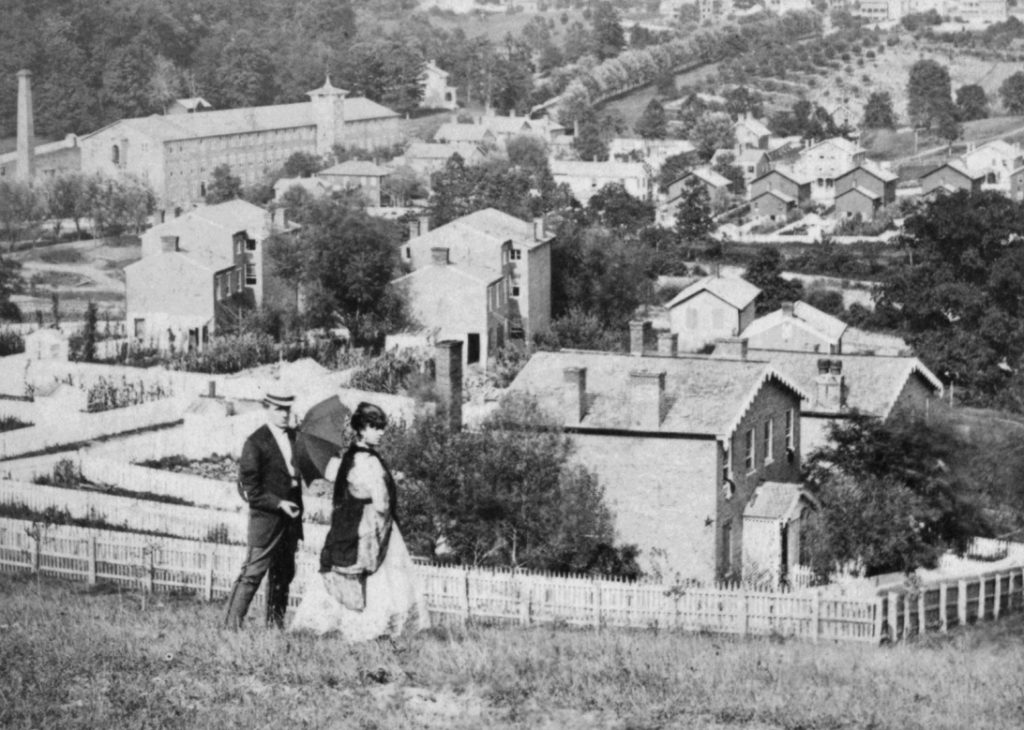History of the Jones Falls Mills
The Jones Falls provided the power that fueled manufacturing in Baltimore in the 19th and 20th centuries. The string of mills built in the valley along the river had an indelible economic and social impact on the surrounding areas, the effect of which can still be felt to this day. With increased investment in and visitation to the mill corridor, Preservation Maryland and our partners will work to install interpretive signs and develop a mobile app that will provide historical context to those visiting and living in the area.

THE PROBLEM
There is a need to preserve the stories of labor history along the Jones Falls as the mills find new life in a rapidly growing part of Baltimore.
THE FIX
Preservation Maryland and our partners will work together on the creation of a series of wayfinding signs along the Jones Falls and partner for a series of outreach efforts connected to the signage.
HISTORY & SIGNIFICANCE
The Jones Falls in Baltimore City, a river connecting to the larger Patapsco, was a key natural resource necessary for the development of grain mills. The Mt. Washington neighborhood was home to the first of Baltimore’s grain mills. Beginning in 1810, several other mills farther south produced grain that was transported via ships in Baltimore Harbor. Later, these mills played another significant part in the industrialization of the City. Mills in the Hampden-Woodbury neighborhood produced the majority of the world’s cotton duck supply, used for ship sails, by the late 19th century. These neighborhoods were also filled with mill workers who had recently immigrated to the United States from countries like Poland, Ukraine, and Russia, adding to the already significant German and Irish working populations.
As markets changed, these industries were no longer in demand, and the mills declined. After decades of non-use, nearly all have been adaptively reused and contribute to Baltimore’s new economic role as a center for start-up companies, the arts, regional cuisine, and more. With the reuse of the mill properties, neighborhoods like Hampden, Woodberry, and Remington are being revitalized with a new wave of young professionals from around the world.
THREATS & GOALS
The renewed vibrancy of the mills as cultural and economic centers is joining them to their surrounding neighborhoods in new ways. As the renovation of all the historic Jones Falls mills is nearly complete, creating wayfinding signage that depicts and describes the mills is a project of immediate importance. The signage, and programming connected to the signage, can foster heritage tourism, strengthen social connection between the mills and neighborhoods, and stimulate new investment in historic commercial business.

Photo Credit: New York Public Library
Updates
DECEMBER 2018
Preservation Maryland has completed the two-year project to research, design, manufacture, and install eight new historic interpretation signs along the Jones Falls. The signed were installed in December 2018 at six of the eight locations and all are available for public viewing online on the Explore Baltimore mobile app and website.
SEPTEMBER 2018
The Society for the Preservation of Old Mills toured the mills of the Jones Falls on a bus tour led by Nathan Dennies of the Greater Hampden Heritage Alliance and organized as part of the larger Six-to-Fix initiative. Over 40 mill enthusiasts from across the Mid-Atlantic attended the tour that included many future locations of new interpretive signed designed as part of this project.
FEBRUARY 2018
Preservation Maryland has been working very closely with the Greater Hampden Heritage Alliance to tell the story of the history of the Jones Falls mills to residents and visitors to the area alike. Alliance board member and historian, Nathan Dennies presented a brief history of the mills to a full crowd at the Hampden Branch of the Pratt Library.
RESOURCES
Greater Hampden Heritage Alliance
“Historic Sites of Industry in the Jones Falls Valley,” Walking Tour, 2018
“The history and development of Jones’ Fall in Baltimore,” Wilber A. Street, 1926
NEWS
12/2018
Fall Mid-Atlantic Conference Re-Cap
Society for the Preservation of Old Mills
10/22/2017
What’s now chic was once ‘pretty abysmal’: a look at Jones Falls Valley’s manufacturing past
Baltimore Sun
Can we count on you?
Preservation Maryland isn’t just preserving the past – we’re investing in our future. In just the past year we’ve invested heavily in our work and refused to accept the mounting challenges as a reason to retreat or hold our position. You are making it all possible.
